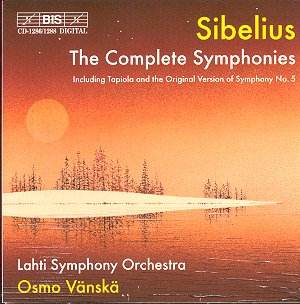I greatly sympathise with Norman Lebrecht in his condemnation of orchestra managements in their rut-stuck obsession with bidding for the 'great name' conductors. A viciously swirling, self-serving and stagnant world chases after Barenboim, Previn, Muti and the rest deaf and blind to the refreshing streams of new names emerging from conservatoires and conducting masterclasses the world over. Birmingham and BBC Glasgow broke that mould with Oramo Sakari and Osmo Vänskä - there are others with that rare trouvaille of integrity, freshness and tension - I think of John Maclaughlin Williams (so far heard only onNaxos) and of Jose Serebrier.
This Lahti Sibelius cycle is healthy and extremely well recorded. The sense of front to back perspective and of quiet details in the foreground registering despite fff activity above is remarkable and a tribute to Ingo Petry, Robert Suff, Jeffrey Ginn and Jens Braun.
This set now supplants the original BIS Järvi/Gothenburg set which I would still like to hear. Indeed I would also like to hear the Gibson and Segerstam on Chandos and the Sakari and Leaper on Naxos and I must mention the French SONY Bernstein set.
The First Symphony bristles with detail and Vänskä drives it along with petulant aggression. He does not have the tone-dazzle of Barbirolli's version - which remains a favourite. The colour achieved is natural, less saturated than Barbirolli-EMI. If you think in visual terms Barbirolli's recording quality is Jack Cardiff's work for The Archers productions rather than the down to earth spectrum of a typical high definition 1990s BBCTV production such as 'Pride and Prejudice'.
The Fourth is played as an intimate concerto for orchestra bringing out, more than many, roots in works such as Rakastava and the lighter world. It is a fine interpretation and the flute, viola and cello voices reach out to the listener in conspiratorial eloquence. The Second Symphony has had many incandescent performances: Barbirolli on Chesky (white hot), Beecham in concert at the Colston Hall and the unsubtle but visceral approach from Rozhdestvensky and the USSRSO (when will his late 1960s cycle be issued on CD?).
The Third and Sixth are works close to my heart. The Third has Mozartian intimacy as well as a bristling urgency. There are few instances of gestural Tchaikovskian heroics. This tautness and perfection of balance and scale is clearly prized by Vänskä making this one of the strongest recordings in the set. Highly recommended - as is the luminous Sixth in which buoyant poise and delight in instrumental dialogue carry all before them.
With the Seventh I wondered at first if the conductor had found the aural equivalent of the mot juste. Until I got to 5.01 when Vänskä's strategy is revealed with its perfectly paced swell and rise I had my doubts. My reference remains the Melodiya Mravinsky Leningrad Moscow recording but this version is high in the stakes. The BIS Tapiola is another miracle of jewelled balance and spontaneity. All Sibelians must hear this.
There are 19pp of Andrew Barnett's (no relation) English notes and the rest of the dumpy booklet includes the notes in French, German and Finnish.
By the way there are 4 CDs in this set. Much as in the case of the BIS Opus Claveicembalisticum and the Holmboe symphonies there are A and B discs. In this case a 1288A and a 1288B. Don't be foxed by the disc numbers.
In the Sibelius symphony stakes Vänskä demonstrates a healthy approach without occupying the highest pastures except in the case of a phenomenal Tapiola.
The set is sui generis in that it gives both versions of the Fifth Symphony. This is part of the legacy of integrity and trust between the Sibelius family and BIS. Rather like the special privilege granted Chandos and Hickox to record the RVW London Symphony in one of the original versions so BIS have the key to much that is fabled and recondite. They have, for example, recorded both versions of the Finn's violin concerto. It is fascinating to hear the Fifth in its four movement 1915 issue playing 35.16 against the 3 movement 31.20 final version of 1919. After so many years of hearing the Fifth in the tighter 3 movement structure it is impossible to make a reliable snap appraisal. All I can do is to celebrate the chance to hear what amounts to a new Sibelius work and encourage you to hear it for the small astonishments and joyous turns of phrase and orchestration you will hear: familiarity jolted by surprise. The level of dissonance in the original version can startle - be warned. It is a must for Sibelians everywhere. Vänskä is at the other pole from the stolidity of Colin Davis in his 'classic' Boston Philips recording. Vanska knows his way to the elusive realm between gestural defiance and grateful descant. His emphatic way with the payoff hammerblows at the end of the familiar version of the Fifth is just on example of a man who has rethought and reinvented the symphony finding a way back through traditions and layers of convention.
Rob Barnett

![]() Lahti SO/Osmo Vänskä
Lahti SO/Osmo Vänskä ![]() BIS CD-1286-1288 [287.30]
BIS CD-1286-1288 [287.30]